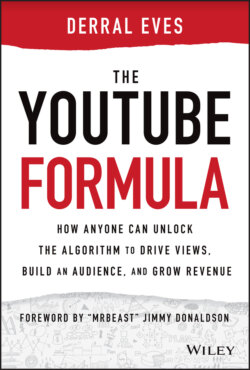Читать книгу The YouTube Formula - Derral Eves - Страница 20
An Evolving, Thriving System
ОглавлениеAs you can see, ad revenue sharing completely changed the YouTube ecosystem. YouTube had been a minefield of instability in its fledgling years. They were learning the hard way that their ecosystem was a delicate balancing act—among its copyright holders, its viewers, its Partners, and its advertisers. There has been an “Adpocalypse,” countless issues with the algorithm, FTC COPPA children's privacy issues, Adpocalypse 2.0, and more. YouTube has learned to deal with the problems and tried to make changes to satisfy the masses, but it is a constant effort.
When we come full circle back to the viewer, the first component in the ecosystem, we have to consider how much the viewer has changed. YouTube really wants to have satisfied viewers. Over the years, they have tried to modify their recommendation feature to figure out exactly what each viewer might want to watch. They know that happy viewers will stay around longer, and viewers who stay around longer will produce happy content creators and happy advertisers. And the more the viewers watch, the more money everybody makes. The thousands of changes that have been made to the algorithm over the years have literally paid off, so the better the algorithm gets, the happier everyone will be. Get ready to dive deep into the algorithm in the next chapters.
YouTube must be figuring out some things, though, because they have seen 31% year‐over‐year growth! In 2020, YouTube announced their revenue for the first time ever. In 2019, they made $15.15 billion, which was nearly double the year before! That is mind‐blowing, in both the amount of money and the percentage of growth. People watch more than five billion YouTube videos a day. Billion. To really grasp how much bigger a billion is than a million, consider this: one million seconds is roughly 11 days, while one billion seconds is 31½ years. Now give a second thought to that $15.15 billion figure for YouTube's 2019 revenue, and gasp. And they are really only just getting started.
YouTube began as a dating website for a handful of college co‐eds in California in 2005. Now it reaches every corner of the globe on every device. Roughly one‐third of the entire population of the earth is watching YouTube regularly. Again, we are talking in billions. Where it used to be a specific demographic, the YouTube viewer is now everyone.
Creators and businesses can proactively position themselves to win on YouTube by learning about their own role in its ecosystem and the mechanics of a good channel. These are nonnegotiables if you want to succeed on the platform. Don't try to game the system; try to align yourself with YouTube's goals so fewer problems come up and you can focus on good content creation. YouTube has changed exponentially since its inception, and its ecosystem has changed, too. If you want to be a part of that ecosystem, you have to understand how it works and how you can adapt to it, because it will continue to change. You can adapt intelligently by looking at the data YouTube gives you. I'll show you how the algorithm works and how to create and adjust from its data.
